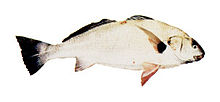|
Spotfin croaker
The spotfin croaker (Roncador stearnsii) is a species of marine ray-finned fish belonging o the family Sciaenidae, the drums and croakers. This species occurs from Mazatlán, Mexico, to Point Conception, California, including the Gulf of California. It is the only species in the genus Roncador. In California, they are most commonly found south of Los Angeles Harbor. They live along beaches and in bays over bottoms varying from coarse sand to heavy mud and at depths varying from 4 to 50 feet or more. They prefer depressions and holes near shore. Description The body of the spotfin croaker is elongate, but heavy forward. The upper profile of the head is steep and slightly curved, and abruptly rounded at the very blunt snout. The mouth is underneath the head (subterminal). The color is silvery gray with bluish luster above and white below. There are dark wavy lines on the side, and a large black spot at the base of the pectoral fin. The subterminal mouth, absence of a fleshy barbel and the large black spot at the base of the pectoral fin distinguish spotfin croakers from all other California croakers. Small "spotties" are sometimes confused with small white croakers, but a count of the dorsal fin spines will quickly separate them; the spotfin croaker has 11 or fewer (usually ten), while the white croaker has 12 to 15. So-called "golden croakers" are nothing more than large male spotfin croakers in breeding colors. Ecology and reproductionSpotfin croakers eat a wide variety of food items. As well as clams and worms, small crustaceans are eaten extensively. They use the large pavement-like pharyngeal (throat) teeth to crush their food. Male spotfin croakers first mature and spawn when two years old and about 9 inches (23 cm) long. Most females mature when three years old and 12.5 inches (32 cm) long. All are mature by the time they are four years old and have reached a size of 14.5 inches (37 cm). The spawning season runs from June to September and may take place offshore, since no ripe fish have been caught in the surf zone. (Juveniles of 1 inch (2.5 cm) appear in the surf in the fall.) Spotfin croaker travel considerably, but with no definite pattern. They move extensively from bay to bay. For example, fish tagged in Los Angeles Harbor were later taken as far south as Oceanside; spotfin tagged in Newport Bay moved to Alamitos Bay and vice versa. Fishing informationAlthough some are caught throughout the year, late summer is best for spotfin croaker fishing. Good fishing seems to depend on runs. When a "croaker hole" is found and a run is on, good fishing can be had by all present whether in a bay, from a pier or in the surf. Most spotfin croaker caught are small to medium-sized fish. The largest recorded specimen was 27 inches, 10.5 pounds. Here are excerpts on historical spotfin croaker fishing from an article by Ed Reis "Crazy Croakers" in the August 2010 issue of Pacific Coast Sportfishing:
References
|
||||||||||||||||||||||||||||||||||||

